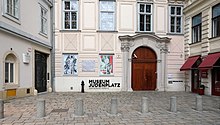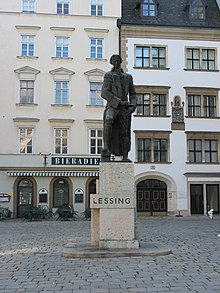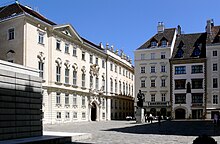Judenplatz
Judenplatz (German, 'Jewish Square') is a
The Austrian
History

Jews began settling in Vienna and in the area that was to become Judenplatz around 1150, coinciding with the settlement of the
At Judenplatz was the Jewish hospital, the Synagogue, the bath house, the house of the Rabbi and the Jewish school- all among the most important in German speaking countries.[4] The synagogue lay between the later Jordangasse and Kurrentgasse streets. Because of the school the square bore the name "Schulhof" as it was a schoolyard at that time. Later this name was transferred to a smaller square situated in the immediate neighborhood, and the neighborhood is still called so today. The designation "Neuer Platz" was given to the original schoolyard in 1423, and since 1437 it has been called Judenplatz.[5]
Vienna Gesera

In Vienna under Duke Albrecht V, the persecution of the Jews in the autumn of 1420 grew to a bloody climax in 1421. In the beginning were many imprisonments, with starvations and tortures leading to executions. Children were deprived and deceived into eating unclean foods, those that were defiant were "sold into slavery" or baptized against their will.[6] The poor Jews were driven out, while the wealthy were imprisoned.[7] The few Jews still living in freedom took refuge in the Or-Sarua Synagoge at Judenplatz, in what would become a three-day siege, through hunger and thirst, leading to a collective suicide,[8] A contemporary chronicle exists, entitled the "Wiener Geserah", translated from German and Hebrew as the "Viennese Decree". It reported that the Rabbi Jonah set the Synagogue on fire for the Jews at Or-Sarua to die as martyrs. This was a form of Kiddush Hashem in order to escape religious persecution and compulsory baptism.[9]
At the command of Duke Albrecht V, the approximately two hundred remaining survivors of the Jewish community were accused of crimes such as dealing arms to the
Holocaust Memorial


In the middle of the northern end of the square, the
Excavations were undertaken to establish the Memorial from July 1995 to November 1998; these are considered the most important urban archaeological investigations in Vienna.[14] Uncovered on the eastern half of the square were quarrystone walls, a well and cellars of a whole block from the time of a medieval synagogue. Controversy arose over the placing of the memorial over the archaeological excavations, which resulted in moving the memorial one meter from its original position on the site.[15] The complete reorganization of the square and its transformation to a pedestrian plaza were completed in the autumn of 2000 with the inauguration of the Holocaust memorial.[11]

Misrachi-Haus

At Judenplatz 8 is the Misrachi-Haus. It was built in 1694 and is today a branch of the Jewish Museum Vienna. Under the square archaeologists found, in 1995, the foundation walls of one of Europe's biggest medieval synagogues and exposed them.[11] With the archaeological findings came the idea to unite the memorial and excavations into a commemorative museum complex.[16]
The erection of a museum sector in the Misrachi-Haus was conceived in 1997 to supplement the show area at Judenplatz 8. In addition to the archaeological findings, exhibitions by a branch of the Jewish Museum Vienna would document Jewish life in the Middle Ages as well as the data base produced by the Documentation Archive of the Austrian Resistance with the names and fates of Austrian Holocaust victims.[16]
In the exhibition, importance is particularly attached to the circumstances of the Jews in "Wiener Geserah", the pogrom in the year 1421. Remains of the synagogue from before the pogrom are to be seen in three areas; these consist of the men's teaching and praying area called the "men's shul", a cultivated smaller area that was used by the women, and the foundation of the hexagonal bimah, the elevated platform for Torah reading.[11]
Lessing monument

In the center of the southern end of the square is the monument to the German poet
Bohemian Court Chancellery

The former Bohemian Court Chancellery (Böhmische Hofkanzlei), Judenplatz 11, is the seat of the Austrian
The building was originally the official seat of the Bohemian Court Chancellery, which was united organizationally with the Austrian Court Chancellery in 1749. In 1848, occupancy changed to the Ministry of the Interior which remained in the palace until 1923. From 1761 to 82 and 1797 to 1840 resided also the Oberste Justizstelle, the forerunner of the Austrian Supreme Court (Oberster Gerichtshof).
References
- ISBN 0-19-514053-2
- ^ Heidrun Helgert, Die spätmittelalterliche Synagoge auf dem Judenplatz in Wien Die Deutsche Gesellschaft für Archäologie des Mittelalters und der Neuzeit e.V, accessed 20 May 2007.
- ^ wissen.de Judenplatz Archived 2007-09-27 at the Wayback Machine, Munich, accessed 20 May 2007.
- ^ a b Museum Online, Das erste Wiener Ghetto Archived 2005-10-30 at the Wayback Machine accessed 23 May 2007.
- ^ Jewish Museum Vienna, Wiener Einstellungen Archived 2007-09-27 at the Wayback Machine accessed 23 May 2007.
- ISBN 0-231-08847-7
- ^ a b Viktor Böhm, Jordanhaus - Judenplatz 2 - 1010 Wien Verein für Geschichte und Sozialkunde, accessed 22 May 2007.
- ^ a b c Camillo Schaefer, Kammerknechte des Herzogs: Die Judengemeinde im mittelalterlichen Wien - Ein historischer Streifzug Archived 2007-09-30 at the Wayback Machine Wiener Zeitung, 1 May 1998.
- ^ a b Gerhard Langer, Der Wiener Judenplatz Archived 2007-03-13 at the Wayback Machine, University of Salzburg: Center for Jewish Culture and History, transcription of a lecture given in 1998 in Vienna.
- ISBN 0-8143-2497-5
- ^ a b c d Jewish Museum Vienna, JUDENPLATZ - Place of Remembrance Archived 2003-04-01 at the Wayback Machine Press release, Winter 2000/2001, accessed 23 May 2007.
- ^ John Tusa, and Rachel Whiteread, Transcript of the John Tusa Interview with Rachel Whiteread, BBC Radio, accessed 4 June 2007.
- ^ Jewish Museum Vienna, flyer[permanent dead link] accessed 23 May 2007
- ^ City of Vienna, Abgeschlossene Grabung 1., Judenplatz - Stadtarchäologie Wien accessed 23 May 2007.
- ISBN 0-300-09413-2
- ^ a b Documentation Archive of the Austrian Resistance, Gedenkkomplex Judenplatz: Ort des Lernens, Ort der Erinnerung Archived 2007-09-28 at the Wayback Machine accessed 21 May 2007.
- ISBN 0-521-83120-2.
- ^ Hedwig Abraham, Siegfried Charoux: Bildhauer, 1896 - 1967 accessed 18 May 2007.
- ^ Austrian Administrative Court of Justice, Baugeschichte Archived 2007-07-02 at the Wayback Machine accessed 19 May 2007.
- ^ a b Austrian Constitutional Court of Justice Gebäude Archived 2007-07-04 at the Wayback Machine accessed 19 May 2007.
- ^ Austrian Administrative Court of Justice, Judenplatz Archived 2007-07-02 at the Wayback Machine accessed 19 May 2007.
- ^ Austrian Administrative Court of Justice, Behördengeschichte Archived 2007-07-02 at the Wayback Machine accessed 19 May 2007.
Further reading
- Judenplatz Wien 1996. Wettbewerb Mahnmal und Gedenkstätte für die jüdischen Opfer des Naziregimes in Österreich 1938–1945. Mit Beiträgen von Simon Wiesenthal, Ortolf Harl, Wolfgang Fetz u. a., Wien 1996
- Simon Wiesenthal (Hg.) Projekt: Judenplatz Wien. Zur Rekonstruktion von Erinnerung, Zsolnay, Wien 2000
- ISBN 3-85431-217-2
- Adalbert Kallinger: Revitalisierung des Judenplatzes. Wien, Selbstverlag, 1974
- Ignaz Schwarz: Das Wiener Ghetto, seine Häuser und seine Bewohner, Wien 1909
- Samuel Krauss: Die Wiener Geserah vom Jahre 1421. Braumüller, Wien und Leipzig 1920
External links
![]() Media related to Judenplatz, Vienna at Wikimedia Commons
Media related to Judenplatz, Vienna at Wikimedia Commons


